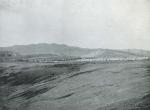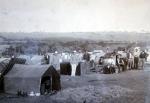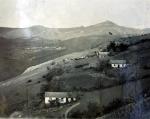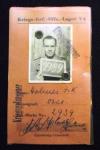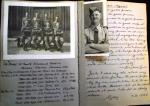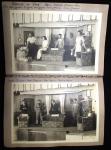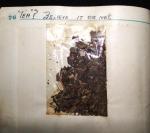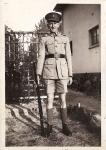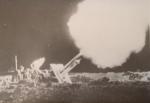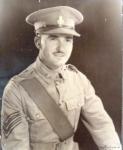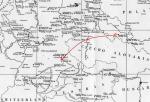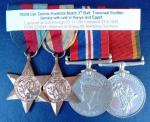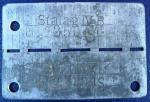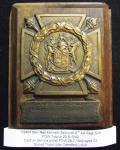
brian conyngham
Past Contributor-
Posts
85 -
Joined
-
Last visited
-
Days Won
4
Content Type
Profiles
Forums
Blogs
Gallery
Events
Store
Everything posted by brian conyngham
-
John I am glad you enjoyed these, not seen that often are ABO's as they are notoriously difficult to research properly. Figures vary regards Boer POWS but if I am not mistaken I believe at least 20 000. Not all claimed their medals as these were only issued from 1920 onward.Bermuda's climate was better than St. Helena and Ceylon must also have been warm. There were also a camps in Portugal and SA. Brits captured by the Boers were often released after taking away their weapons and boots especially later in the war as they did not have the facilities to keep them and rations were low. The most famous Anglo Boer War POW in South Africa was Winston Churchill, he was held captive by the Boer's in Pretoria until he escaped! Glad you enjoyed these 3 stories. Brian
-
Artillerist Andries Stephanus Eloff State Artillery Andries Eloff was born on the 30th January 1875 and Christened on the 4th July 1875. The Eloffs were a prominent Afrikaner family, based largely in the Rustenberg area of the Transvaal. President Paul Kruger’s daughter Elsie Francina married Frederick Christoffel Eloff, the son of Sarel Johannes Eloff, a life-time friend of the President. The Kruger’s also farmed in the Rustenberg area. A number of Eloffs took part in the 1877 First Dorsland (Thirst land) Trek. Their aim was to leave the Transvaal and settle in an area around Humpata, in Angola. This First Dorsland Trek was not that successful with many dying from tropical sickness and hardship, relating to their difficult almost “Amish” lifestyle. A number of disillusioned Trekkers returned to the Transvaal, however, many decided to settle in the Grootfontein area of South West Africa. The area they settled in became known as the Republic of Upingtonia, named after the Prime Minister of the Cape Sir Thomas Upington. By 1885 many of these early settlers had given up hope and dispersed, some returned to the Transvaal and a few others moved into German settlements in South West Africa. A Second Dorsland Trek took place in March 1892, when some one hundred families left the Transvaal. Around forty families of this trek once again settled in Grootfontein area, whilst the rest trekked on into Angola. In 1893 saw further groups of Transvaal Dorsland Trekkers move north into South West Africa and Angola. (Note: The last of these Dorsland Trekkers only returned to South West Africa and South Africa in 1974, when Angola became independent from Portugal and Civil War had broken out!) It is unknown on which of the later expedition’s Andries Stephanus Eloff undertook, but we do know he did trek and ended up living in the Grootfontein settlement/area. It was here on the 19th February 1895 he married Neeltjie Christina Bester. Ten months later they had a daughter born on the 5th December 1895. Like so many Boer families, she was named after her mother. On the 1st September 1896 the young Neeltjie Christina Eloff was christened, at Grootfontein. The years 1896/97 brought excessive rains to the region, which unfortunately was followed by a severe fever epidemic in Grootfontein. Andries sadly lost his young wife to the fever on the 4th May 1897; this left him with a seventeen month old daughter to look after. It would appear after his wife’s passing he returned to the Transvaal? Records indicate another marriage to a Groenewald took place, but research has so far turned nothing up to confirm this. One of his younger brothers Sarel Johannes Eloff died at the age of 22 on the 6th July 1899, at Louis Trichardt. The cause of his death was due to an explosion at Fort Schutte near Louis Trichardt, during the War with Magato, a local African Chief in the area. At the start of the Boer War in October 1899, he gave his address as Potgieter Street, Pretoria. At the age of 25 he attested to serve in the war against the British forces in October 1899. His father Emmanuel Andries Eloff and brother Ernst Hendrik also joined up, along with a number of other Eloff family members. His father at the age of 50 served as a member of the ZARP, whilst Ernst rode with the Rustenburg Commando, along with many others of the extended Eloff family. Andries however joined the State Artillery, serving under Commandant Loubser and General Cris Muller. The following battles are claimed on his Vorm “B”: Dundee (Battle of Talana) 20/10/1899 Colenso (Battle of) 15/12/1899 Donkerhoek (Battle of Diamond Hill) 11/6/1900 to 12/6/1900 En nog Unfortunately a number of months of campaigning are possibly missing, however, he might have possibly returned to Pretoria to man the many forts in and around the Boer Capital? The comment “En nog” (English translation: and more) does not help. He was taken prisoner on the 9th August 1900 in Pretoria. Less than a month after being captured he was shipped off the Ceylon on the ship City of Vienna. They departed South Africa on the 3rd September 1900 and arrived in Ceylon on the 25th September 1900. He was allocated to Ragama Camp whilst a POW in Ceylon. Ragama Camp besides being the camp where the Foreign Boer Fighters were interned was also the camp where “Boer dissidents and irreconcilables were kept”. A Jewish Boer by the name of Weinberg described the foreign Boer Volunteers at Ragama as follows 'The Germans, Hollanders, Irish Americans are, with a few exceptions, a most disreputable lot. They are without exaggeration the scum of the scum'. Unfortunately we do not have Eloffs return date home. It is however likely that as an “irreconcilable” Eloff would have only returned home long after the War had ended. Ragama was the last POW camp to close in Ceylon. (Irreconcilables was a term used by the British mainly for Boers who refused to sign an allegiance to King Edward VII. This allegiance gave them free passage home) His daughter Neeljie Christina Eloff survived the return trek to the Transvaal from South West Africa, and the War with possible Concentration Camp life for a young 5 year old? She later married a Johannes Andries Stephanus du Plessis, on the 3rd March 1915. (Note: The du Plessis family connection is strong with both the Eloff’s and the Kruger’s. Andries mother was Johanna Hendrina du Plessis, President Kruger’s first wife Anna who died and his second Gezina, were both du Plessis. The du Plessis family also took a prominent part in the Dorsland Treks.) The Boer Dorsland Trekker and Boer War Veteran Andries Stephanus Eloff passed away in 1934, at the age of 59. His daughter Mrs N C du Plessis applied for her father’s ABO medal after his death and her application was approved, unfortunately there are no date stamps on Andries Eloffs claim Vorm “B”. Neeljie Christine Eloff passed away on the 24th April 1975, at the age of 79. She is buried in the Zandfontein Cemetery, Pretoria Transvaal.
-
Sergeant Nicolaas Jacobus Jacobs Field Telegraph Section O.F.S. Artillery Nicholas Jacobs 20 lived in Meyersfontein in the district of Boshoff in the Orange Free State. He worked in the Criminal Investigation Department, Bloemfontein OFS. When the War broke out he attested on the 27th September 1899 with the OFS Forces, serving with the Telegraph Section of the OFS Artillery. He served under General Hertzog, Maj Albrecht and Col Brand all out of Bloemfontein. His campaign during the War covered the OFS, Transvaal and Cape Colony. The following battles and skirmishes are by him claimed on his Vorm “B”: Kimberley (Siege) +- 25/11/1899. Magersfontein (Battle) 11/12/1899 to 12/12/1899. Houwater (Skirmish near Prieska) 5/3/1900 Sannaspost (Battle) 31/3/1900 Mostershoek (Reddersburg) (Battle) 3/4/1900 to 4/4/1900 Thabanchu (Engagement) 28/5/1900 Wepener (Siege) 9/5/1900 to 25/5/1900 Rustenburg 11/7/1900 Fauresmith (Attack) 19/10/1900 Koffiefontein (Siege) 26/10/1900 to 3/11/1900 Jagersfontein 16/10/1900. Boers under command Gen J B M Hertzog released prisoners. Etc.etc 8 Months of campaigning is unfortunately missing with entries of ect.etc as he was taken prisoner on the 7th June1901, near Fauresmith. Two months later on the 16th August 1901 he was shipped on the “SS Montrose” to Bermuda, arriving on the 13th September 1901. This shipment of 932 POW’s were allocated to Tucker’s and Morgans Islands in the Great Sound of Bermuda. However according to the records held in the Bloemfontein Museum he was allocated to “Burt’s Island” camp, whilst interned in Bermuda. This was the smallest of the camps holding approximately 360 prisoners. All indications point to this camp developing into a centre for those totally opposed to the British, and most adept at influencing their fellow prisoners to hold firm. They were classed as “irreconcilables”. His return to South Africa is unknown but due to his interment on Burt’s Island, he might have come home later than most of the other Boers, who had signed the Declaration Allegiance to King Edward VII. Signing the Allegiance document ensured a free and early return home. He applied for an ABO and his application was approved on the 27th June 1921. No further info has been found on the life of Nicholaas Jacobus Jacobs.
-
Artillerist Martinus Johannes Bekker State Artillery Martinus Bekker was born around 1872 and lived in the Waterberg district. He attested into the State Artillery with the outbreak of War with the British from the 11th October 1899. He gave his rank as Adjutant on his Vorn “B”, however, there is another inscription placed by persons unknown that give him the rank of Artilleris. The following actions are claimed by him: Ladysmith (Siege) 1900 Biggarsberg (Battle of Dundee/Talana) 20/10/1899 Witrand? Dalmanutha (Battle of Belfast Coalmine/Bergendal) 21-27/8/1900 Helmertia Machadadorp (Battle) 29/12/1900 En verskilende ander klein gevechte (English translation: And a number of other smaller battles/skirmishers) He was captured on the 26th October 1901 at Zusterhoek. On the 17th January 1902 he departed South African shores on board SS Orient caring 1,050 prisoners for St Helena Island. At St Helena he was held at Deadwood camp, where he is recorded as being an Adjudant. He was held at Deadwood until August 1902. He was a late claimant for an ABO; his application being approved on the 22/3/1945. No further info has been found on the life of Martinus Johannes Bekker.
-
Paul you have to live in Africa to believe what goes on here, more so north of our borders but it does seem to be creaping in here as well. Personally I hated this man and all he stood for, I opened a beer when I heard he had died. He typifies everything that is bad about African leaders. Democracy in African terms is a bad word but used as a smokescreen to get the West to keep filling the ever empty begging bowl. The preferred way to rule in Africa is the Feudal system, the chief or leader is all powerful and just dare go against him...you will fail, just ask Comrade Julius Malema the fallen ex ANC Youth League leader. Rant over, sorry to ruffle any feathers. Brian
-
Chris I do believe that when worn the ribbon must always have the yellow stripe facing left as in the DTD/DSO group illustrated. If you were from the Vrystaat you wore the Vrystaat coat of Arms facing outwards and boers from the Transvaal wore their Coat of Arms facing outwards. So suspect the Vrystaat example shown in the first post is incorrectly displayed? Regards Brian
-
POW DIARY LT. J.K. Holmes South African Police Battalion POW Tobruk 20/6/1942 Italy P.G. 47-PM 3200 Modena Italy Oflag 5A Weinsberg Germany The following diary was acquired 2 years back, it covers this Officers POW years of enternment in detail. Great care was obviously taken to document his enternment. It also clearly displays the differance between how the Officers and Other Ranks were treated! There are pages and pages of day to day activities with photographs and interesting a few items such as POW camp money, leaves taken plants during walks outside the camp, and even some 70 YEAR OLD POW CAMP TEA! Officers spent much of their time partaking in plays, sports, playing card games etc. This of course is not how the average private and NCO spent their time in captivity. Sadly this diary did not come with his medals. I will post a few pictures of the diaries contents, hope you all enjoy.
-
Hubert Edward Patten Trooper, S.A.T.C. (South African Tank Corps) Patten was born in Durban, Natal, the son of Edward and Louis (born Kitson) Patten on 11 December 1898. Despite having been old enough to have served in the Great War there is no evidence to suggest that he did so. The smooth running of the Patten household was disturbed on 30 October 1932 with the passing away of Louisa Patten in Durban. Hubert, still single at the age of 34, continued to live in the family home. With the outbreak of war in South Africa having taken place on 6 September 1939 many chaps heeded the call to mobilisation which only came once the Union Defence Force had got its house in order in the early stages of 1940. Patten was such a man. According to records held in the archives of the South African National Defence Force, in June 1940 Patten was described as being a Clerk with the South African Railways & Harbours. He stood 5 feet 9 inches tall and had blue eyes, a fresh complexion and fair hair. He weighed 142 lbs and was a Wesleyan by way of religious affiliation. He was still single and gave his next of kin as his father, Edward Patten of 111 Northway, Durban North. He was 41 years and 7 months old. On 27 June 1940 he attested at Stamford Hill, Durban for the duration of the war with the rank of Private, no.213984, with the Railways & Harbours Brigade of the South African Tank Corps. Patten assumed duty on 24 September 1940 and was posted to Voortrekkerhoogte with the Railways &Harbours Brigade of the S.A.T.C. and then to 21 Armoured Car Company (R&H) S.A.T.C. On 8 November 1940 he was sent on Course 3, S.A.T.C. Wireless Operators to the School of Signals, S.A.C.S. at Potchefstroom being nominally posted to the 21 Armoured Car Company (A.C.C.) – A.F.V.T.C. (Armoured Fighting Vehicle Training Centre) at Kaffirkraal four days later on 12 November 1940. The course was to last for six weeks and, on 19 December 1940, on completion thereof, Patten was returned 21 A.C.C. On 17 March 1941 Patten was transferred from 21 Armoured Car Company to “B” Company, 7th Recce Battalion. 7 SA Armoured Car Reconnaissance Battalion was formed in the Union on this date as an amalgamation of Nos.21 and 22 Armoured Car Companies (South African Railways and Harbours) Between 23 - 25 May 1942 he was hospitalised with septic sores on hand before embarking at Durban per S.S. “Ile de France” for the Middle East with 7 Recce Battalion on 9 June 1941. After a voyage of some eleven days Patten disembarked at Suez on 20 June 1941 and, together with the 7 Recce Battalion, commenced operations against the Axis Forces in North Africa. On 24 September 1941 his basic rate of pay increased from 2/6 to 3/10 per day. A watershed moment in Patten's life was about to be reached when he was declared Missing believed P.O.W. (Prisoner of War) – 7 Recce Battalion. (Ech. 920) on 20 June 1940. This was, of course the day that the Panzerarmee took Tobruk. Patten was in Tobruk at the time Rommel attacked at dawn on the 20 June 1942 and, with the rising of the sun on 21 June 1942, General Kloppers had surrendered and Patten, alongside 33 000 other Allied soldiers of whom 10 722 were South Africans, was rounded up by the German forces and was “in the bag” as a Prisoner of War. Most of Patten’s Regiment’s Armoured Cars were destroyed at Tobruk between 20th-21st June 1942, either in action during the defence of the Garrison, or by purposeful destruction of war material prior to the General Surrender. Thereafter, the 7th SA Armoured Car Regiment ceased to exist as a fighting unit, and was disestablished in the Middle East, 6th September, 1942. (Upsurge, BWM) On 16 September 1942 he was confirmed as a Prisoner of War and, on 24 September 1942, in absentia, his basic rate of pay increased from 3/10 to 4/2 per day on completion of two years service. A bitter irony considering the fact that he was incarcerated. P.o.W. Records indicate that Patten was captive in Italy in 1943, but his placement is unrecorded. This could indicate that, either he was on a work party or labouring on a farm somewhere in the Italian countryside. He is recorded in lists of German held P.o.W’s in September 1944 and March 1945 as being held at Stalag VIII-B at Teschen, Silesia, which was amongst the Lamsdorf group of camps. These camps began to be evacuated from about the 22nd January, 1945, as the battlefront with the Soviet Red Army drew progressively nearer to their locality. The prisoners were marched under armed guard westwards into the German interior, in columns of 200-300 at a time – the so-called long march which caused hardship, privation and even death for many. On 13 May 1943 the war in North Africa came to an end with the last of the Axis troops expelled from the continent. On 11 May 1945 Patten was taken on strength of the U.D.F. Repatriation Unit (x P.O.W.) – Released P.O.W. arriving as a Released P.O.W. in the U.K. the next day. On 19 May 1945 he was taken off strength of the U.D.F. Repatriation Unit for evacuation to the Union and granted 30 days leave from 26 May – 24 June 1945. This was followed by a further 6 days leave from 25 – 30 June 1945 before he embarked for the Union on 4 July 1943. On disembarkation at Cape Town on 3 August 1945 Patten was taken on strength of the Cape Fortress and told to report to C.A.T.D. Oribi Camp (Pietermaritzburg) on 4 August 1945. He was taken on strength of the Dispersal Depot, Durban from N.M.R. Snell Parade (in absentia) on 6 October 1945 and discharged from the service on 19 October 1945. Trooper Hubert Edward Patten was allowed to reckon service of 5 years 26 days of which almost three years were as a Prisoner of War in both Italy and Germany. He was regarded as being of Very Good Character, Sober of Habits and of Good Efficiency. Having participated alongside his regiment in the battles of Halfaya (12 - 17 December 1941; Agedabia (15 December - 1 February 1942) and Bardia 1942 (31 December, 1941 - 2 January, 1942) Patten was awarded the 1939/45 Star, Africa Star, The War Medal 1939/45 and the Africa Service Medal. They were posted to him on 3 April 1952. On return to civilian life Patten married Mabel Catherine Head in Durban on 5 July 1946. At the age of 48 his bachelor days were a thing of the past. Hubert Edward passed away in Entabeni Hospital, Durban, aged 69 years on 8 May 1967. He was resident at 23 Ennisdale Drive, Durban North at the time of his death and was a Retired S.A. Railways Pensioner. He was survived by his wife. There were no children of the marriage.
-
Steve I personally like the knobkerrie, not sure if you know this but some were made from the root part of the Tree right were the ground starts (a natural ball forms in some trees), others of course where the branch comes out the tree. An elderly African chap I worked with some years ago used to make them for a few spare bob. When we in the bush he was always looking for certain hard wood trees so he could harvest them for conversion into these "head-bangers". I always regret never buying one or two examples from him. Sadly in this collecting area a 50 year old item can look like a 140 year old example, a rather specialised field. Many of these items come from rural areas where they can easily weather and get the feel and smell of an old item. Keep away from any that have coloured wire binding as these were made in the last +-40 years...plastic coloured wire is collected from telephone cables! The metal binding at the rear of your throwing spear could well be a counter balance, allowing the spear to fly further and true! Regards Brian
-
Corporal William Graham Fairbairn 2nd Divisional Signalling Company S.A.C.S. (South African Corps of Signals) Wounded at Fordsburg during the 1922 Miners Strike, serving with the RDLI. (POW Tobruk repatriated via Sweden) Fairbairn was born in London, England on 19 January 1902 the son of John George, a Timberman, and Jane Anne Fairbairn. At some early stage of his life he immigrated to South Africa. He joined the DLI soon after the end of the 1st World War. He served for four years in the ACF and during this time was called up with the rest of the regiment to assist in putting down the Miners Strike of 1922. During the strike that had turned violent Fairbairn was wounded at the action at Fordsburg on the 14th March 1922. It is undocumented in the official history of the Durban Light Infantry exactly the circumstances surrounding Fairbairn injury, except to say “wounded” and “Fordsburg”. It must therefore be presumed that as he was the only member of “A” Coy wounded as they did not take part in the attack on the 14th, Fairbairn must have been on detached duty with either “C” or “D” Company who were involved in the fighting at Fordsburg? On 1 April 1939, we find him passing his Drivers Test which licences him to drive petrol driven light vehicles on South African roads. According to records held in the South African National Defence Force Archives, in August 1940, Fairbairn was a Sales Manager with Lever Brothers in Salt River, Cape Town by profession. On attestation he was 38 years 6 months old, stood 5 feet 9 inches tall, weighed 136 pounds and had blue eyes, a fair complexion and brown, slightly greying, hair. By religious affiliation he was Church of England. His next of kin was his wife, Edna Audrey Fairbairn of “Sherwood”, Corniston Road, Rondebosch, Cape Town. This was later changed to P.O. Box 20 Cape Town. In the records Fairbairn claimed to have seen 4 years of Active Citizen Force Training and to being a Reservist with the Durban Light Infantry (see section on “Miners Strike” section). On 22 July 1940 he attested at Potchefstroom for the duration of the war, as Signaller, number 17371 (V), with No. 3 Divisional Signal Company, South African Corps of Signals. On 1 August 1940 he is taken on strength of No. 1 Divisional Signal Company, South African Corps of Signals ex No. 3 Divisional Signal Company. Admitted to S.A. Military Hospital at Potchefstroom with “flu” on 25 August 1940 being discharged from hospital on 1 September 1940 Fairbairn was then promoted to Lance Corporal and posted to No. 2 Divisional Signal Company on 12 December 1940 and promoted to War Substantive rank of Corporal on 1 March 1941 On 2 June 1941 he obtains a Certificate from “Q” Services Training Centre at Sonderwater, Premier Mine, confirming that he attended a Mechanical Transport Course (“Q” 47 – qualifying) from 21 April – 12 May 1941. He qualified in all the prescribed subjects with an overall pass mark of 73%. On 10 June 1942 Fairbairn embarked at Durban for the Middle East per S.S. “Ile de France” disembarking at Suez 10 days later on 20 June 1941 Commenced operations against the Axis Forces in North Africa. (Egypt) On 30 July 1942 he is admitted to hospital with an undisclosed ailment and discharged from hospital on 2 August 1941 Fairbairn is re-mustered as an “A” Class Artisan Fitter (Mechanised Transport.) - 12 April 1942 On 20 June 1942, exactly one year after disembarking in North Africa, Fairbairn is “Missing believed P.O.W.” and posted to the x3 list. being confirmed as a Prisoner of War on 18 August 1942 Fairbairn, like thousands of others was “in the bag” at Tobruk where, with the garrison hopelessly surrounded, General Klopper ordered the Surrender of the Allied Force under his command. 20 June 1942, the “Battle of Tobruk” has a deep significance among South Africans. On 18 November 1942 he is transferred to Campo 65 at Gravina in Italy, fifty kilometres south – west of Bari on the heel of Italy. Like many P.O.W. camps in Italy, Campo 65 was ill prepared for the influx of prisoners and had only half finished bungalows and very rudimentary facilities to meet them with. It is said that, had the conditions and the diet the men were fed, not improve drastically, there would have been many a death from starvation. The Italians surrender to the Allies on 8 September 1943 - With the capitulation of the Italian Forces, the Italian guards deserted their posts at the various POW camps. Unfortunately for most, the German army arrived almost at the same time to take over the camps. Before long the majority of Prisoners, Fairbairn included, were transported east to Prussia for incarceration there. Fairbairn was held at Stalag 344 (VIII B) at Lamsdorf in Poland. He was allocated No. 31803. On 1 October 1943 he is admitted to the sick bay at Stalag VIII B with Chronic Nephritis. His Blood Pressure at the time was 150/95. On 1 November 1942 he is transferred to the Convalescent Block to await the decision of the Medical Commission Authority. On 24 December 1943 Fairbairn receives his kit issue of one pair of pants, one pair of underpants and one shirt. On 26 April 1944 he is recommended for repatriation and appears before a Commission where his repatriation is authorised by the Chairman of the Mixed Doctors Commission. On 3 July 1944 Fairbairn signs for receipt of a Next of Kin parcel issued via the London Committee of the S.A. Red Cross Society. (Parcel was sent on 24 January 1944) On 7 September 1944 Fairbairn leaves Germany for the UK for purposes of repatriation on medical grounds. He receives a letter dated September 1944 from the British Legation in Stockholm, Sweden which reads as follows: As His Majesty’s representative in Sweden it is my proud privilege to extend to you personally on behalf of my wife and myself, the staff of the British Colony in Sweden our friendliest greetings on your arrival in this country. You can depend on it that a great welcome is awaiting you at home after the years of separation from your loved ones and the sacrifices you have made for them. You are returning home at a moment when the enemy you have so stoutly fought is broken and on the run and when you can look forward to the early enjoyment of the peaceful and happy days, which you have so richly earned. God bless you and good luck. Victor Maller Fairbairn was repatriated to the UK via Sweden and taken on strength of the Repatriation Unit (Released POW’s) on 20 September 1944 On 29 September 1944 he is taken on strength, UDF Repatriation Unit and embarked for South Africa disembarking at Durban, ex UK, and is taken on strength at Base Depot, Durban. Reclassified medically as “D” - 18 October 1944 Fairbairn is taken on strength at Base Depot Voortrekkerhoogte ex Base Depot, Durban on 20 October 1944 and, after a spell of leave, is told to report to B/D Voortrekkerhoogte on 7 January 1945 On return he is posted to the S.A. Military College to attend Course 1415 P on 8 January 1945 but he is destined not to make it as he is admitted to Voortrekkerhoogte Military Hospital the next day, being discharged from hospital on 15 January 1945 Soon after, on 18 January 1945, Fairbairn is admitted to Wynberg Military Hospital being discharged from there and taken off strength S.A. Military College to Dispersal Depot at Westlake, Cape Town two months later on 18 March 1945 Taken on strength at Westlake Dispersal Depot, Cape Town - 19 March 1945 Fairbairn is issued with an Invalidity Badge Certificate in respect of Badge No. 40260 on 22 March 1945 and is discharged and demobilised from the army having been declared Medically Unfit by a Medical Board on 23 March 1945 William Graham Fairbairn was allowed to reckon service of 4 years and 245 days, many of which were spent as a Prisoner of War. His Character on discharge was rated as Very Good. He was regarded as Efficient and Sober. Now aged 43, Fairbairn was granted a civilian clothing and cash allowance of 15 pounds. His address was now recorded as Roxburgh Flats, Meadow Road, Rosebank, Cape Town. Fairbairn completed the Application for Medals form on 6 September 1945. He was awarded the 1939/45 and Africa Stars with the War and Africa Service Medals. These were despatched to him 16 years later on 11 February 1961. On 27 December 1945 Passport No. C 18835 is issued to Fairbairn at Cape Town. This was applied for to enable Fairbairn to take up a transfer with Lever Brothers to Southern Rhodesia. He had returned to their employ after discharge. A letter is received from Mr. A.D. Courley, the Chairman of Lever Brothers, to Fairbairn in Salisbury, Rhodesia informing him as follows: ‘In view of your good work and the recent increase in your responsibilities I am glad to advise you that the Board has decided that your salary shall be increased by 250 pounds per annum to 1 250 pounds per annum as from the 1 April 1947. It gives me great personal satisfaction to be able to be able to advise you of this recognition of your services to the Company, and I would like to take the opportunity to extend to you the best wishes of my colleagues and myself for your continued success in the future.’ In 1964 William Graham Fairbairn passed away, aged 62, survived by his wife Ivy Myrtle Fairbairn, born Glover, and his children.
-
89707 Gunner Charles Percy Wasserman Chapman 5th Battery 2 Field Regiment (Natal Field Artillery) SAA. (Escapee from Tobruk) Chapman an auctioneer and market clerk by trade with the Pietermaritzburg municipality attested at Pietermaritzburg on the 20th May1940 at the age of 36 years and six months. He had been born on the 29th November 1903, was single and gave his mother Mabel Chapman as his next-of-kin. He was initially allocated to the 4th Battery, 2nd Light Brigade SAA but was posted to the 6th Battery on the 20th June 1940. On the 25th January 1941 he was posted to the 2nd Field Brigade SAA (N.F.A.) and allocated to “B” Battery. He suffered from piles and had to be admitted to hospital due to this ailment. They embarked at Durban per S.S. Dilwara on the 22nd July1941 for the Middle East. They disembarked at Suez on the 12th August1941. With re-organisation taking place the various SAA units were renamed and numbered, “B” Battery became the 5th Battery, 2nd Field Regiment (N.F.A.). He served with this battery and according to his papers was taken prisoner on the 13th June1942 but according the unpublished History of the NFA, he was initially posted as “Missing in Action” on the 20th June 1942. It appears he was separated from his Troop during/after the Battle of Kings Cross near the Tobruk perimeter. He later escaped from the enemy, and re-joined the Union Forces a few days later. Back in Allied hands and without a unit, as the NFA were all taken prisoner, he was transferred to the 1st Field Regiment SAA (Cape Field Artillery), on the 10th July1942. He served with them in the field until the 11th December 1942, when he embarked at Suez to return to the Union, and arrived in Durban on the 1st January 1943. He underwent a course and further training whilst in the Union and returned to the Middle East on the 1st October 1943. The 1st Field Regiment SAA was combined with the 6th Field Regiment SAA for service in Italy with the 6th SA Armoured Division. As a composite unit they became known as the 1/6th Field Regiment SAA. He served with the unit in Egypt and Italy from the 1st October until the 16th June 1945. At the end of the Italian Campaign, he was shipped home arriving on the 25th July 1945. He was finally discharged on the 31st August 1945. His full medal entitlement included the 39/45 Star, Africa Star with 8th Army Clasp, Italy Star, British Defence Medal, The War Medal and Africa Service Medal. This can be considered a rather scarce group as there were not many Tobruk “escapers”. The vast majority of them whom were taken POW and within hours escaped were re-captured within a few days. They all suffered mainly from thirst and hunger, lack of transport also being a major factor. He must have been amongst the very few who found a serviceable abandoned vehicle, and used it to get back to Allied lines.
-
89817 Ernest Henry Densham 2nd Field Regiment SAA (NFA) (POW Battle of Rigel Ridge 13/06/1042) Densham a British national had been born in Bristol on the 21st October 1907 and a farmed in the Underberg district of Natal on the farm “Waterford”. At the age of 32 years and 8 months he attested as a gunner with the 2nd Light Brigade (NFA) at Pietermaritzburg, on the 25th June 1940. Densham claimed a short period of 3 months service with the Devon Regiment when attesting. He was posted to “C” Battery NFA whilst undergoing training at Potchefstroom on the 25th January 1941. The 2nd Field Brigade was renamed the 2nd Field Regiment and “C” Battery was re-designated as 6th Battery with the re-organisation of the SAA on the 1st February 1941. On the 28th July 1941 the unit embarked at Durban per SS “Dilwara” for the Middle East and they disembarked 2 weeks later on the 12th August 1941 at Suez. He was captured with the rest of the 6th Battery NFA at the Battle of Rigel Ridge on the 13th June 1942. This SAA battery has gone down in history as staying at their guns and fighting until over-run by German tanks. Many tributes were received including this one from the CO of the 8th RTR Lt-Col Sherwell, which reads as follows: “The officers and men of the 6th Battery performed their duty with a determination, steadfastness and courage quite unsurpassed and no praise can be too high for the extremely gallant action they fought” A few of the members of the 6th Battery had managed to escape capture on that fateful day and made their way to Tobruk. Their freedom was however short lived, as they were all taken prisoner a week later when Tobruk capitulated to the Axis forces on the 20th June 1942. According to his POW debrief records Densham was first interned at Suwanee Ben Adem in Northern Tripoli from the 27th June 1942 until the 13th November 1942 before being taken to Campo 66 in Italy. He was interned there from approximately the 1st December 1942 until March 1943. From March 1943 until 11th August 1943 he was transferred and interned at Campo 54 at Fara Sabina. He escaped from this camp with 2 fellow artillerymen L/Bdr James and Gnr Hill; the 3 of them remained on the run for 3 months, being hidden by friendly Italian’s. He was subsequently recaptured by the Germans on the 31st December 1943 and sent to Stalag 8B at Moosberg and interned there from the 21st January 1944 until the 8th February 1944. As POW No 275313 he was transferred to Stalag 4B at Muhlberg serving there from the 8th February 1944 until the 10th June 1944. (Strangely his SA Military records state that he was held at Stalag 4A at Hohenstein, but this camp is not recorded on his POW debrief dated 15th May 1945?) At Muhlberg possibly due to his strong physique as a farmer, he was transferred to Zittau POW camp, this was a “Working Camp” and in the records he claimed to have served there from the 10th June 1944 to the 8th May 1945, manufacturing Cement Blocks. He claimed that he did not receive adequate medical treatment from the Italian authorities but was happy with the treatment he received from the Germans. He is recorded as arriving in the UK on the 13th May1945 as a released POW and was placed on the strength of the UDF Repatriation Unit, which was based at Brighton. Due to delays in getting the many ex-servicemen and woman back to the Union he was only flown back home on the 10th June 1945 and after being granted leave was finally discharged on the 21st September 1945. His full medal entitlement is a 39/45 Star, Africa Star, The War Medal and Africa Service Medal, which were dispatched to him on the 9th September 1955. I discovered a web site detailing the exploits of an Ernest Hall who was also a member of a Zittau Arbeitskommando (Work-group) and it reveals interesting information regards these working camps. Earnest Densham left the camp at Zittau at the same time so would have possibly experienced the same experiences as Ernest Hall if not exactly the same.(One can but wonder if they in the same group fleeing the Russian army?) Ernest Hall recalls: I had been one of a working party (Arbeitskommando) of thirty ‘other rank’ British prisoners of war living and working in Zittau since October 1943. We had been captured in Tobruk, North Africa on 21st June 1942 and had been imprisoned in a large prisoner of war camp in Northern Italy. After the collapse of the Italian Fascist government and the surrender of its successor to the British and American allies, we had been transported to Germany, to Stalag IVb at Mühlberg, and thence to Zittau. Transported to Germany after the collapse of Mussolini’s government, we had spent two days and nights in cattle trucks before arriving at Stalag IVb near Mühlberg. Here, as ‘other rank’ British prisoners of war, we were showered, deloused, photographed and finger-printed, inoculated, medically examined and – eventually – issued with new underclothes and British Army uniforms, presumably provided by the Red Cross. We had spent two – or was it three? – days at Stalag IVb. Then a group of 30 of us, all found medically fit for heavy work (Schwerarbeit) were sent with just one guard to Zittau to become Arbeitskommando 1153. Although we had been processed at Stalag IVb we discovered that we were now an outpost of Stalag IVa. In Zittau we were lodged in Neustadt in the town centre, in what remained of the old Town Theatre, most of which had been destroyed by fire. We occupied a day room and a dormitory on the first floor. Our guards lived on the ground floor below us. It wasn’t long before we became almost as familiar with Zittau as with our hometowns in Britain. We got to know its cobbled streets and squares, its narrow alley-ways, its centuries-old buildings and, of course, its railway sidings. From this base we went out to work, in parties of two, three or four, every day. Our work mainly consisted of loading and unloading railway wagons at Zittau Railway Station and at other railway sidings in and around the town. When available though, we did any other heavy manual work that was needed. We helped deliver groceries and greengroceries from wholesalers to retail shops in the area. We loaded produce from local farms onto lorries and unloaded them at their destinations. We swept the streets, dug graves in Zittau cemetery, worked in a local bakery, in an iron foundry, in a jam factory and, in fact, anywhere else where our labour was required. I departed from Zittau on 7th May 1945 amid the thunder of artillery fire through which could be heard the no-longer-distant chatter of machine guns and the occasional whine of an approaching shell. It was obvious that the town would be part of the battlefield within days, if not within hours, we marched southwards out of Zittau into what is now the Czech Republic and into the Sudeten Mountains, away from the inexorable advance of the Soviet Army. As we climbed into the Sudeten foothills we watched Zittau experience its first air raid as Soviet aircraft dropped bombs on the town. We spent a chilly night in a barn with the sound of gunfire all around us. The next day we began our journey home! Joined by other POWs being evacuated from the battle area, we had spent the previous night in a barn high in the mountains. In the bitter chill of early morning we continued our march, with heavy firing going on all around us. Halfway through the morning our guards called us together and announced that they had heard on the radio that the war was over. SS Units, members of Hitler’s elite corps, were – as was all too evident - fighting on in that area but they were not members of the SS. They threw away their rifles and told us that they intended to change into civilian clothes and make their way to their homes as quickly as possible. They suggested that we should do the same, and we needed no second bidding! We decided to make for Prague where, so we heard, Czechs had revolted against German occupation and had liberated the town before the arrival of Soviet forces. At first we set out in a column but split into groups of no more than two or three when we found ourselves coming under air attack from both sides. Soviet pilots imagined that we were a German column while the pilots of German aircraft, flying westwards to surrender to the British or Americans, emptied their machine gun magazines on what I suppose they thought were Soviet troops. Walking and cadging lifts in the backs of lorries fleeing southwards, we spent the night on a Czech farm just outside Leitmeritz (now Litomerice), which was believed to be occupied by Soviet forces. The following morning we saw German stragglers withdrawing past the farm and heard that the fighting in and around Leitmeritz was over. After a number of train hair-raising train and plane trips he eventually arrived at Prague and then onto Rheins in France from where they were finally flown home to England in the belly of a Wellington bomber
-
Peter Really glad you and the other members of the GMIC are enjoying this thread. The medals might all be the same BUT they all tell a different story. Sadly for many of these soldiers, the War was the highlight of their lives and nothing else quite topped off these years of wearing a uniform and serving their country. I spent a number of evenings enjoying many a pint and listening to war stories from WW2 Vets at a local Moth Club (Memorial Order of Tin Hats, an ex Servicemens club), when I was busy with my 2 years National Service, way back in the late 1970's. Brian
-
2338 Sgt. Edgar Norman Kidd 2nd Batt. Royal Durban Light Infantry POW Tobruk 20th June 1942) Kidd was born on the 11 September 1909 in Durban, South Africa and was a chemist by trade. He was married to Dorothy and had one child of 14 months when he attested at the age of 35 on the 30 May 1940 at Oribi Camp, Pietermaritzburg for war service with the 2nd Battalion RDLI as a Sergeant. Kidd had served on and off with the D.L.I during peacetime with the service number 42300 from 1 July 1927 through to 1 July 1935, rising through the ranks from Private to L/Sergeant during this period. He embarked at Durban on the 20 July 1941 and disembarked on the 12 August 1941 at Suez. He was promoted to substantive rank of sergeant on the 17 May 1942. He was captured a month later at Tobruk on the 20 June 1942. He was interned at various P.O.W. camps in Libya (Benghazi), Italy (Camp 65 Gravina and Camp 52 at Chiavari) before finally being interned in Germany with the P.O.W. number 31665 at Stalag V111B at Lamsdorf (November 1943-March 1945) and took part in a "Death March" to Stalag 383 at Hohenfels (March to April 1945). With the allied advance into Europe he was finally released and arrived in England on the 4 May 1945. According to the official regimental history of the Durban Light Infantry by A.C. Martin, Kidd went on to be commissioned as a Lieutenant with the unit, after the war. His full medal entitlement consists of the 1939-45 Star, Africa Star, British War Medal, Africa Service Medal and Efficiency Medal & Clasp (Missing) Medals shown as worn, I do however plan to fix this group up with a clasp when one can be acquired!
-
78508 Cpl. Dennis Roderick Mutch 3rd Battalion Transvaal Scottish. POW Sidi Rezegh 23/11/1941 Dennis Roderick Mutch was born on the 3rd August 1929 and attested at the age of 19 years and 8 months with the Union Forces on the 10th May 1940 at Benoni Johannesburg, Transvaal. He was a clerk by trade and a Prespetarian by religion. He gave his mother Anne Kobott (Mutch) living at 4, Prince Alfred St. Queenstown as his-next-of-kin. Allocated to the 3rd Transvaal Scottish he carried out his initial training in South Africa from the 1st June until the 6th March 1941.During this period he was promoted to Corporal in August 1940. During November 1940 he was hospitalised with a Hernia and had to undergo an operation. He went on to serve in Kenya with the 3rd Tvl. Scottish from the 6th March 1941 late April1941. He disembarked for service at Suez on the 3rd May 1941. He was granted 7 days leave from the 7th –14th August 1941. He took part in the Battle of Sidi Rezegh and was reported missing over that eventful night of the 22/23rd November 1941. At the end of the battle the 3rd Battalion, The Transvaal Scottish were destroyed. There is some uncertainty in his papers and two forms it is recorded that he was only captured on the 11th December 1941, this date is crossed out and 23-11-43 written over it! Did he possibly initially avoid capture only to be picked up later attempting to return to allied lines? According to his records he spent time in Italian and German POW camps. The group came with his German POW ID Disc, which gives the camp as Stalug 1V B, which was at Muhlberg on the Elba River. He was repatriated via England arriving there on the 30th May 1945. He returned to the Union 2 months later on the 26th August 1945 being finally discharged on the 10th November 1945, after serving for 5 years and 148 days in uniform. He returned to his pre-war clerical duties being employed with the National Chemical Products Ltd. Germiston, Johannesburg. His full medal entitlement consists of the 1939-45 Star, Africa Star, British War Medal and Africa Service Medal. Group came with his German POW ID disc as well as his grandsons SA General Service medal from the 1980’s-1990’s era.








